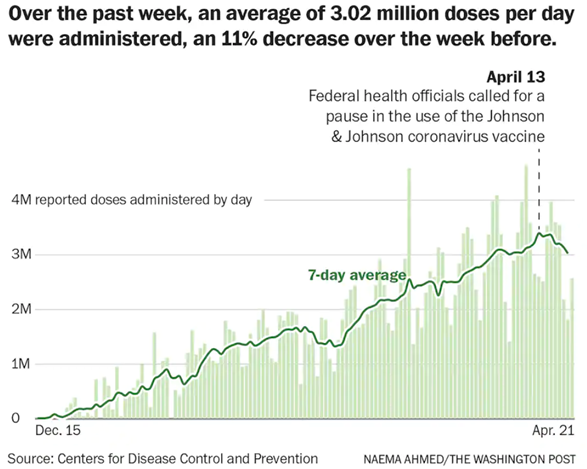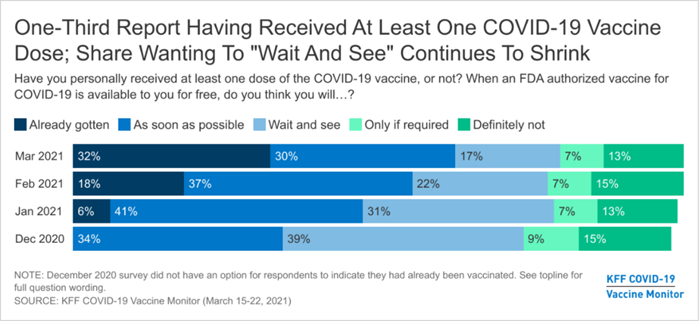In the U.S., it may look like beating COVID-19 should be easy now. There are multiple, highly effective vaccine options, and anyone over the age of 16 is now eligible. What’s more, scheduling appointments may not be necessary for much longer. A robust network of vaccination sites consisting of pharmacies and mass community vaccination centers will soon be accessible to 90% of Americans within 5 miles from their homes. All in all, multiple barriers have been removed in just a few short weeks.
And yet, the fight is far from over. Persuading the last 37% of adults to get vaccinated—some taking a “wait and see” approach and others “determined not to get vaccinated—is our latest challenge.2 Employers can play a crucial role in making headway with this reluctant group.
Now is the time to take action, as vaccination uptake is slowing down. The 7-day average of daily coronavirus vaccinations dropped by 11% the week of April 21 compared to the previous week (Figure 1).

Softening demand appears to be highlighting two resounding issues that remain unsolved: trepidation of some Americans about getting vaccinated and the remaining barriers they face in accessing the vaccines. Together, these factors may be enough of an obstacle to prevent the U.S. population from reaching the levels of protection needed to bring about an end to the COVID-19 pandemic.3
One piece of good news is that fewer people are taking the stance that the vaccine is not “right for them”; however, the reduction is not significant enough, especially among those with the strongest opposition.

Because the battle to turn the tide on vaccination continues to be difficult, it may be time for employers to build up their incentive strategy. Some employers may have delayed any incentive efforts until all employees had access to the vaccine; now that eligibility guidelines have been lifted, it may be time for employers to fully actualize their vaccine incentive strategy.
The next phase of the vaccination effort will require a tailored approach and an understanding of what may be that last necessary motivating factor for those still postponing scheduling their vaccine appointments.
Paid Time for Vaccinations
Employees without access to paid time to get the vaccine may face the decision between a full paycheck or getting the vaccine. Employers can remove this enormous barrier and support equitable access by ensuring that all employees have the time and flexibility needed to get vaccinated. In fact, paid time off is the cornerstone of the Biden Administration’s call to action for employers. On April 21, 2021, President Biden called on “every employer in America to offer full pay to their employees for any time off needed to get vaccinated and for any time it takes to recover from the after-effects of vaccination”.4
Several large employers have already taken action to provide paid time to their employees. The approach can vary across employers, from providing a new, dedicated time- away benefit for vaccination, to offering flexible scheduling and updating and/or communicating existing leave benefits and attendance policies. For more information on employer considerations and real-world examples, visit the Business Group’s Time Off & the COVID-19 Vaccine resource.
A March 2021 Business Group survey found that the top three approaches employers use to encourage vaccination are scheduling flexibility, designated time off and encouraging employees to use existing time off. Anecdotal evidence from employers indicates that these strategies are becoming more common, particularly the ability to provide scheduling flexibility.
Other Incentives
For many employers, other vaccination incentive strategies have been contingent on vaccine availability. With increased supply and universal eligibility, many employers may be looking into deploying an incentive strategy that suits their population and organization as a whole.
Beyond providing paid time off for vaccination, other incentives employers may consider offering include:
- Financial Incentives: A small gift card or paycheck deposit may be just enough to help convince some employees still on the fence about vaccination and signal employers’ support for getting vaccinated
- Raffles among those who get fully vaccinated.
- Incorporating vaccination incentive into existing wellness points programs (in some cases, leading to financial incentives).
- Offering prizes through existing recognition platform.
- Making charitable donations of the employees’ choosing.
It’s unlikely that a single initiative will convince every employee to get vaccinated. The attitudes and perceptions of those questioning the benefit of the vaccine will continue to evolve as more get vaccinated and the upside of being vaccinated becomes clearer. However, incentive strategies similar to those used by employers to encourage other health-related behaviors such as well-being screenings and flu shots may very well for some be one final push to get vaccinated.
This phase of vaccinations requires patience and flexibility. Equally important is knowledge about which strategies are most effective for each subsegment within the overall employee population c
References
- 1 | Ritchie H, Ortiz-Ospina E, Beltekian D et al. “Coronavirus (COVID-19) Vaccinations”. Our World in Data. https://ourworldindata.org/covid-vaccinations. Accessed May 6, 2021.
- 2 | Huetteman E. “Covid Vaccine Hesitancy Drops Among All Americans, New Survey Shows”. Kaiser Health News. March 30, 2021. https://khn.org/news/article/covid-vaccine-hesitancy-drops-among-americans-new-kff-survey-shows. Accessed May 6, 2021.
- 3 | Keating D, Nirappil F, Stanley-Becker I. “U.S. sees significant drop in vaccinations over past week.” Washington Post. April 21, 2021. https://www.washingtonpost.com/health/2021/04/21/vaccinations-downturn-jj-pause-soft-demand. Accessed May 6, 2021.
- 4 | The White House. “FACT SHEET: President Biden to Call on All Employers to Provide Paid Time Off for Employees to Get Vaccinated After Meeting Goal of 200 Million Shots in the First 100 Days”. April 21, 2021. https://www.whitehouse.gov/briefing-room/statements-releases/2021/04/21/fact-sheet-president-biden-to-call-on-all-employers-to-provide-paid-time-off-for-employees-to-get-vaccinated-after-meeting-goal-of-200-million-shots-in-the-first-100-days. Accessed May 6, 2021.
